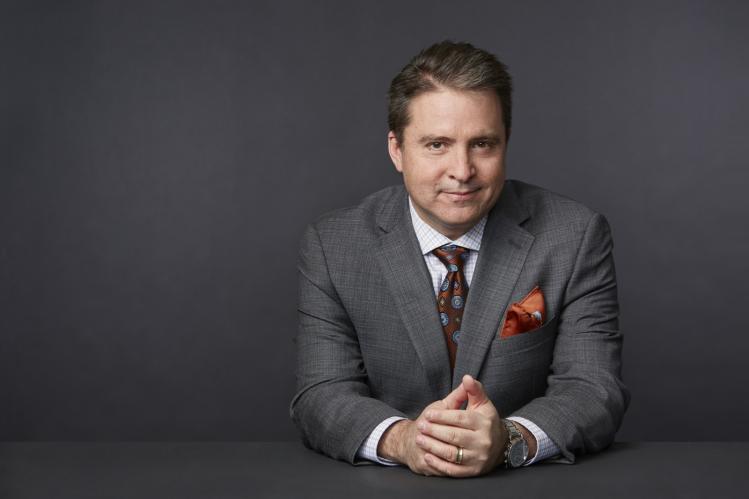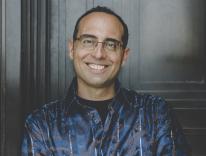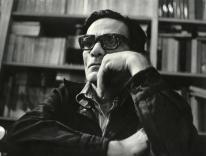
Interested in discussing this article in your classroom, parish, reading group, or Commonweal Local Community? Click here for a free discussion guide.
Robert P. Jones is the CEO and founder of Public Religion Research Institute (PRRI) and writes regularly on politics, culture, and religion for the Atlantic, NBC Think, and other outlets. He holds a PhD in religion from Emory University and a MDiv from Southwestern Baptist Theological Seminary. He is the author of The End of White Christian America, which won the 2019 Grawemeyer Award in Religion. Assistant editor Regina Munch spoke with him about his new book, White Too Long: The Legacy of White Supremacy in American Christianity, and current attitudes among white Christians on issues of racial justice. You can listen to the full episode here. A transcript of the interview follows, edited for length and clarity.
Regina Munch: Tell us about the argument of White Too Long. What makes it so urgent today?
Robert P. Jones: The subtitle of the book is The Legacy of White Supremacy in American Christianity. I think when we talk about the Church and civil rights, most people think of African-American churches and the role that they played in promoting civil rights and helping to organize the civil-rights movement. But what has not received that much attention is the role that the white Church played in resisting the civil-rights movement. White Christianity and white churches have been wrapped up in and infected with white supremacy all the way back to the beginning of the country.
RM: The argument in your book goes further than saying that white Christianity was merely complicit in racism and racial injustice. You argue that white Christians and white churches actually built and reinforced white supremacy. How did they do that?
RJ: I think at best you’ll hear that the church was complicit, that it somehow got dragged along by some outside force—by Southern culture, for instance. But I think a plain reading of history doesn’t support that. What you see is white Christian churches serving as hubs of white supremacy, just as the African-American churches were serving as hubs for civil-rights organizing. The first Confederate battle flags, for example, were sewn by women organizing through churches.
But even more important than that is the legitimizing factor that white Christianity played. It baptized a worldview of white supremacy. By “white supremacy,” I don’t only mean people in sheets burning crosses, but a worldview in which whites were literally superior to African Americans, and anyone whose skin was darker than theirs or who didn’t originate in Western Europe. There was a belief in a divinely ordained world where whites were, by God’s design, meant to be at the top of the social, political, and cultural pyramid. There’s no greater source of legitimacy than to say something was dictated and handed down by God and supported by the Bible, and this is exactly the role that white Christian churches, both Protestant and Catholic, played.
RM: You talk about the type of relationship with God that’s encouraged in Evangelical Christianity, a very individualist way of thinking about one’s salvation. What does that have to do with white supremacy?
RJ: One of the consequences of the emphasis on a personal relationship with Jesus is that it is so hyper-individualistic—an internal, psychological, and emotional kind of connection to God. When the beginning and the end of religion is seen in that kind of relationship, what gets screened out are social injustices and systemic injustices, particularly around race. It becomes a way for white Evangelicals in particular to feel very comfortable with their own personal religion in a way that’s very disconnected from any claims about inequality or injustice by their African-American brothers and sisters. It falls on deaf ears because it’s considered outside the realm of what’s most central to being Christian.
RM: This is a very personal book. You grew up in a church that was part of the Southern Baptist Convention. What was it like to grow up in that church, and how did your view of it change as you grew older?
RJ: I grew up for the most part in Jackson, Mississippi, as a Southern Baptist. Our denomination, the Southern Baptist Convention, was founded in 1845, literally over the issue of slavery. There was a dispute between Northern and Southern Baptists over whether a member of the clergy could legitimately own slaves, and whether that was compatible with Christianity. The Southern churches took the position that it was, and when their Northern Baptist brethren disagreed with them, they split to form their own convention so that they could hold on to the idea that slavery, white supremacy, and Christianity were compatible. By the middle of the twentieth century, that denomination was the largest Protestant denomination in the country. It really does mark American Protestantism.
I didn’t find that out until I was in seminary in my early twenties. I was at church all the time—five days a week, for worship services a couple of times on Sunday, and then all kinds of church activities like youth group—and I had never heard this. I felt a little betrayed, actually, by not getting a serious understanding of our history—hearing zero sermons on racial justice, white Christianity’s complicity, or this entanglement of white supremacy in our history.
RM: In the book you keep coming back to a paradox: How can a church that has done so much demonstrable good for people within the church also have been so violent and destructive toward others? You bring up two words: protection and purity.
RJ: This book is not a finger-wagging book by somebody from outside who thinks there’s nothing good in the church. I wouldn’t have written this book if I did not have a great love for the church. I’ve been deeply shaped and formed by this tradition in both good and bad ways. This idea of purity and innocence I think is the biggest stumbling block. It’s personal, right? If some of the best parts about ourselves have been formed by the church, how can it also be true that some of these awful things in our history are true? I just think those two things can be true at the same time. If we white Christians want to hold on to and pass down the good to our children and grandchildren, I think there’s no way to do that without seriously wrestling with the bad and doing everything we can to put a sharp and bright light on it so that we can excise it, so that we’re handing less of a muddled mess down to the next generation.
RM: What did Catholics have to do with white supremacy in the United States?
RJ: Catholics in this country have a complex history. Where I live now in Maryland, which was a heavily Catholic state, records show that as many as a fifth of the Catholics even in the late 1700s in Maryland were enslaved Africans, most of whom had been forcibly converted to Catholicism after their enslavement. But Catholics have faced their own history of discrimination. I think people often forget that the Ku Klux Klan, which had a revival in the early part of the twentieth century, was not just an anti-Black organization. It was also an anti-Catholic and anti-Jewish organization that literally saw Catholics as a threat to American democracy.
At the same time, during the Great Migration, African Americans sometimes moved into what had been historically Catholic neighborhoods, and there was racial conflict there. One of the ways that the official Church responded was with segregation. Rather than letting African Americans go to the local parish, they designated one parish, St. Mark’s, as the place where African Americans were to go and where their children had to attend Catholic school. As one African-American priest said, that’s not in the “bad, bad South”; that’s in the “good, good North” that this happened.
In the 1960s and ’80s, the bishops released statements on race that called on people to support equal rights for African Americans. But Fr. Bryan Massingale has shown that by 2004, two-thirds of Catholics reported that they had heard no homilies on race through the entire three-year lectionary cycle. Only 18 percent of bishops had issued a statement. Formal statements don’t make it down into the pews, and when we look at contemporary attitudes among Christians, white Catholics have attitudes regarding race very similar to those of white Evangelicals and white mainline Protestants.
RM: You did a study about racist attitudes among white Christians and compare them to opinions among white Americans who are not affiliated with a church. How did you go about that study and what did you find?
RJ: One of the patterns that I noticed was that on issues of race, and particularly on issues of systemic racism, there were huge gaps between whites who identified as Christian of any kind, whether they were Protestant or Catholic, and whites who claim no religious affiliation at all. And in virtually every one of these questions, it’s whites who were not Christian who held views closer to those of African Americans.
We set up what I call a “racism index” that used fifteen questions to cover topics from Confederate monuments and flags, to systemic issues like the killing of African-American men by police. We scored this index on a scale of one to ten, with ten meaning the most racist attitudes. White Evangelicals score eight out of ten on this racism index. But what I think is more surprising is that white Catholics and white mainline Protestants score seven out of ten, while white, religiously unaffiliated Americans only score four out of ten. It was consistent question after question. Even when we controlled for things like partisanship and location, this independent relationship between white Christian identity of any kind, Protestant or Catholic, and holding more racist attitudes stood up in a very robust way.
RM: Those are very startling findings. How do you account for this? What are some things that white Christians and white Americans in general are doing to address white supremacy?
RJ: I think if you’re someone who has a history like me—if you’re white and you’ve had a fairly positive experience in the church—I think the reaction to hearing those numbers is shock. I should also add that in the study, attending church does not make one less racist, and that’s true for both Catholic and Protestants. That’s pretty shocking if you’re from inside that world. But what’s notable is that the people who aren’t shocked about these numbers are African-American Christians.
We actually have some new data from PRRI that shows some movement among white Catholics on the issue of the killing of Black men by police. In 2015, right as the Black Lives Matter movement was getting started, we asked whether killings of unarmed Black men by police were isolated incidents, or part of a pattern of how police treat African Americans. Seventy-one percent of white Catholics said they were isolated incidents; this was similar to responses from white Evangelicals and white mainline Protestants. But in our last survey, seven out of ten white Evangelicals are still saying that these are isolated incidents, while the number of white Catholics saying that has actually dropped down to 56 percent. Far more white Catholics today than five years ago are seeing these events as part of a pattern of how African Americans are treated by police.
So what can be done? What’s not going to fix this are statements from denominational hierarchies or bishops. What does matter is what happens at the local congregational and parish level. At the end of the book I talk about two churches: the two First Baptist churches in Macon, Georgia, the town where my parents grew up. The churches have a shared history. One of them is predominantly white and the other is predominantly Black, and the ancestors of the African-American church were enslaved by the ancestors of the white church. In the last few years, the two pastors have gotten together to talk about this shared history and begin to build some bridges that have demanded some serious soul-searching by the white church. One example: The white church found in their archives that early in their history, the church was having a hard time paying the bills. One way they balanced the books is by selling enslaved members of their own church. You can actually see in the ledger money coming in from the sale of their own enslaved members, and then money going out to pay for the building and the pastor. I think coming face to face with that history has been a real turning point. It is in these kinds of covenanted, long-term, community-building, relationship-building, organic exercises where the change is going to come, not from declarations and statements. The work is much harder than that.
RM: The title of the book comes from James Baldwin, who said that many Americans have been “white too long” to reckon with racism. What message do you want white Christians to hear about their own whiteness and their relationship with God?
RJ: I read a lot of James Baldwin in doing the research for this book. He, like Martin Luther King Jr., was deeply disappointed in white Christians. He wrote these words in a New York Times editorial:
I will state flatly that the bulk of this country’s white population impresses me, and has so impressed me for a very long time, as being beyond any conceivable hope of moral rehabilitation. They have been white, if I may so put it, too long; they have been married to the lie of white supremacy too long; the effect on their personalities, their lives, their grasp of reality, has been as devastating as the lava which so memorably immobilized the citizens of Pompeii.
Those words really stayed with me. When you hear these contemporary public-opinion numbers, one reaction I hear from many of my fellow white Christians is, “How can this be?” How can it be that church attendance makes no difference? How can it be that white Christians have such a difficult time seeing systemic racism compared to whites who are not Christian? But I think when you take the history seriously, the question shifts from “How can this be?” to “How could it be otherwise, given this history?” The challenge for white Christians is what I titled the first chapter of the book: “seeing.” Just to see what’s in front of us, and then once we see it, to have the courage to tell the truth.
I’m resisting the urge to move straight to reconciliation. It’s too easy to say, “Okay, we’re going to see it. We’re going to lament this awful past. We’re going to apologize for it. Black people are going to forgive us and then we’re going to move on.” But that skips the deeper question of justice and repair. If we’re thinking about a Christian understanding of repentance, it has to be much more than just an apology. The white pastor in Macon said to me, “I’ve stopped talking about reconciliation and we’re just talking about justice.” I think the reason he said that is because if white Christians do enough of the work of repair and making things right, the question of reconciliation is going to work itself out. That’s a product of the work of repair and justice.
Please email comments to [email protected] and join the conversation on our Facebook page.
Previous Story
Barrett vs. Scalia
Next Story
False Choices


